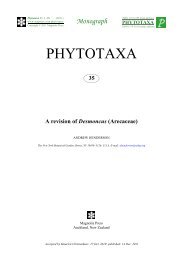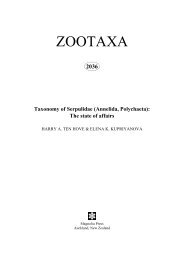You also want an ePaper? Increase the reach of your titles
YUMPU automatically turns print PDFs into web optimized ePapers that Google loves.
the insufficiently sealing glass-stoppered containers (and, to a lesser part, due to post-war alcohol theft). Most<br />
importantly, all of the museum’s accession catalogs were destroyed in 1943. Each taxon description will thus have<br />
to be evaluated individually to ascertain the identity of types and their current location. This task is further<br />
complicated by the facts that the sequential sales catalogs combine and restock specimens from various locales and<br />
collecting events under the same number, and that specimens with manuscript names were widely traded, directly<br />
or via third parties, often before their formal description appeared in print. Numerous museum collections around<br />
the world contain such “ex Museum Godeffroy” specimens and various nomina nuda and incorrectly assigned<br />
authors on their labels have found their way into published listings (e.g., Nevill 1884).<br />
TAXA NOTES<br />
1. Mousson wrote a series of papers on material from Graeffe, four of which (1869, 1870a, 1870b, 1871) were<br />
devoted to specific island groups. His 1869 paper, as shown in the title was devoted to mollusks of Samoa.<br />
Mousson (1869: 369) listed the species name Melania subexusta Mousson, under which he then listed “Var.<br />
persulcata Mousson” giving its locality as “Hab. Upolu.”<br />
Mousson described this variety, referring to it as “this species, which belongs to the fauna of the Viti islands<br />
whose diagnosis will be published in a forthcoming report devoted to the species of this archipelago, is found in<br />
Upolu, represented by some individuals”. In short, Mousson stated that a species of Melania from Fiji, which was<br />
to be described later, had a subspecies on Samoa which he described as M. persulcata Mousson, 1869. This action<br />
makes M. persulcata the nominotypical species.<br />
Mousson (1870b) finally described Melania subexusta from Ovalau [Fiji] with two subspecies, M. persulcata<br />
and M. albizonata Mousson, 1870. In the 1870 description of persulcata no mention is made of the earlier<br />
introduction of the name and there is no mention of Samoa, the only localities given being “Mango et Ovalau”. The<br />
1869 and 1870b descriptions are somewhat different and it will be left to Melania specialists to determine the status<br />
of these nomina. In any event, M. persulcata cannot be subordinate to M. subexusta.<br />
2. The name plumescens was never used as a species name in Modiola or Perna by Dunker. Clessin (1888: 129, pl.<br />
33, figs. 8–9) described Modiola tumescens, attributing it to “Dunker in schedis.” Lynge (1909: 131, pl. 2, figs.<br />
13–14) listed and figured “Modiola plumescens Dunk[er]”. Lynge’s reference for Dunker was “Museum<br />
Godeffroy, Catalog IV, 1868, p. 115” and he listed “Modiola tumescens Dunker (Clessin)” as a synonym. In the text<br />
Lynge stated that Clessin incorrectly used the name tumescens but there is no evidence for that statement as Clessin<br />
referenced only “Dunker in schedis.” The error may well have been in Catalog IV. The most recent treatment of<br />
this species is by Huber (2010: 123) as “Modiolus plumescens (Dunker, 1868)” which should have read Modiolus<br />
tumescens (Clessin, 1888).<br />
3. The genus group name Isselia first appeared in Schmeltz, 1874[V]: 104, 110. In a footnote on page 104 he wrote<br />
[translated] “the changes of names of the remaining rissoines marked by *) is based on communications from Mr.<br />
O. Semper in Altona.” In the same footnote it is stated that Rissoina mirabilis Dkr. [= Dunker] is the type of a new<br />
genus Isselia. As R. mirabilis Dunker is a nomen nudum, Isselia is invalid. It was treated by Weinkauff (1881: 67)<br />
who evidently recognized that Isselia had been validly used for a different genus since 1874 when he described<br />
Rissoina (Isseliella) mirabilis, attributing it to Dunker. For a modern treatment see Ponder (1985: 95).<br />
4. The name Nanina subcicercula first appeared as a nomen nudum in Schmeltz, 1874[V]: 91. No record of its use<br />
by Mousson has been located. It next appeared when its dentition was figured as Nanina subcircula [sic] Mousson<br />
by Binney (1875: 248, pl. 20, fig. 1). Garrett (1881: 362) treated Microcystis subcicercula Mousson with reference<br />
to Schmeltz and Binney (also with a citation by Pfeiffer that is a ‘name only’ listing). Garrett stated that he<br />
supposed the species had not been described and gave a description, attributing the name to Mousson. Binney’s use<br />
was included with a query in the synonymy of Hiona scalpta Garrett, 1884, a placement also used by Baker (1940:<br />
172).<br />
The most recent mention of the name located is in Brook (2010: 251) who cited it as Lamprocystis (Avarua)<br />
subcicercula (Garrett, 1881). Both Brook and Baker (1938: 74; 1940: 172) declared that Binney’s “radula figures<br />
MOLLUSCAN TAXA OF THE MUSEUM GODEFFROY OF HAMBURG<br />
Zootaxa 3511 © 2012 <strong>Magnolia</strong> <strong>Press</strong> · 65
















